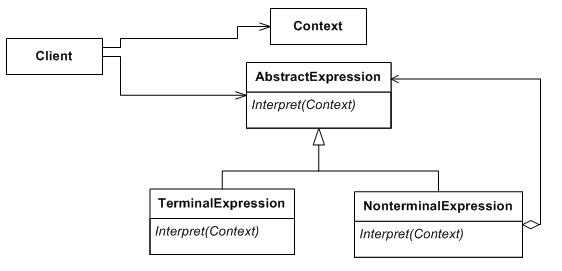Interpreter pattern
In computer programming, the interpreter pattern is a design pattern that specifies how to evaluate sentences in a language. The basic idea is to have a class for each symbol (terminal or nonterminal) in a specialized computer language. The syntax tree of a sentence in the language is an instance of the composite pattern and is used to evaluate (interpret) the sentence for a client.[1]:243 See also Composite pattern.
Uses for the Interpreter pattern
- Specialized database query languages such as SQL.
- Specialized computer languages which are often used to describe communication protocols.
- Most general-purpose computer languages actually incorporate several specialized languages.
Structure

Example
BNF
The following Backus-Naur Form example illustrates the interpreter pattern. The grammar
expression ::= plus | minus | variable | number plus ::= expression expression '+' minus ::= expression expression '-' variable ::= 'a' | 'b' | 'c' | ... | 'z' digit = '0' | '1' | ... | '9' number ::= digit | digit number
defines a language which contains Reverse Polish Notation expressions like:
a b + a b c + - a b + c a - -
C#
This structural code demonstrates the Interpreter patterns, which using a defined grammar, provides the interpreter that processes parsed statements.
//IVSR: Interpreter design pattern namespace IVSR.DesignPaterns.Interpreter { // "Context" class Context { } // "AbstractExpression" abstract class AbstractExpression { public abstract void Interpret(Context context); } // "TerminalExpression" class TerminalExpression : AbstractExpression { public override void Interpret(Context context) { Console.WriteLine("Called Terminal.Interpret()"); } } // "NonterminalExpression" class NonterminalExpression : AbstractExpression { public override void Interpret(Context context) { Console.WriteLine("Called Nonterminal.Interpret()"); } } class MainApp { static void Main() { Context context = new Context(); // Usually a tree ArrayList list = new ArrayList(); // Populate 'abstract syntax tree' list.Add(new TerminalExpression()); list.Add(new NonterminalExpression()); list.Add(new TerminalExpression()); list.Add(new TerminalExpression()); // Interpret foreach (AbstractExpression exp in list) { exp.Interpret(context); } // Wait for user Console.Read(); } } }
Java
Following the interpreter pattern there is a class for each grammar rule.
import java.util.Map; interface Expression { public int interpret(Map<String,Expression> variables); } class Number implements Expression { private int number; public Number(int number) { this.number = number; } public int interpret(Map<String,Expression> variables) { return number; } } class Plus implements Expression { Expression leftOperand; Expression rightOperand; public Plus(Expression left, Expression right) { leftOperand = left; rightOperand = right; } public int interpret(Map<String,Expression> variables) { return leftOperand.interpret(variables) + rightOperand.interpret(variables); } } class Minus implements Expression { Expression leftOperand; Expression rightOperand; public Minus(Expression left, Expression right) { leftOperand = left; rightOperand = right; } public int interpret(Map<String,Expression> variables) { return leftOperand.interpret(variables) - rightOperand.interpret(variables); } } class Variable implements Expression { private String name; public Variable(String name) { this.name = name; } public int interpret(Map<String,Expression> variables) { if(null==variables.get(name)) return 0; //Either return new Number(0). return variables.get(name).interpret(variables); } }
While the interpreter pattern does not address parsing[1]:247 a parser is provided for completeness.
import java.util.Map; import java.util.Stack; class Evaluator implements Expression { private Expression syntaxTree; public Evaluator(String expression) { Stack<Expression> expressionStack = new Stack<Expression>(); for (String token : expression.split(" ")) { if (token.equals("+")) { Expression subExpression = new Plus(expressionStack.pop(), expressionStack.pop()); expressionStack.push( subExpression ); } else if (token.equals("-")) { // it's necessary remove first the right operand from the stack Expression right = expressionStack.pop(); // ..and after the left one Expression left = expressionStack.pop(); Expression subExpression = new Minus(left, right); expressionStack.push( subExpression ); } else expressionStack.push( new Variable(token) ); } syntaxTree = expressionStack.pop(); } public int interpret(Map<String,Expression> context) { return syntaxTree.interpret(context); } }
Finally evaluating the expression "w x z - +" with w = 5, x = 10, and z = 42.
import java.util.Map; import java.util.HashMap; public class InterpreterExample { public static void main(String[] args) { String expression = "w x z - +"; Evaluator sentence = new Evaluator(expression); Map<String,Expression> variables = new HashMap<String,Expression>(); variables.put("w", new Number(5)); variables.put("x", new Number(10)); variables.put("z", new Number(42)); int result = sentence.interpret(variables); System.out.println(result); } }
See also
- Interpreter (computing)
- Backus-Naur form
- Domain specific languages
- Design Patterns
- Combinator#Combinatory logic in computing
References
- ↑ 1.0 1.1 Gamma, Erich; Helm, Richard; Johnson, Ralph; Vlissides, John (1994). Design Patterns: Elements of Reusable Object-Oriented Software. Addison-Wesley. ISBN 0-201-63361-2.
External links
| The Wikibook Computer Science Design Patterns has a page on the topic of: Interpreterimplementations in various languages |
- Interpreter implementation in Ruby
- Interpreter implementation in C++
- SourceMaking tutorial
- Interpreter pattern description from the Portland Pattern Repository
| ||||||||||||||||||||||||||||||||||||||||